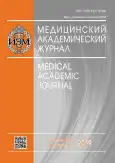Особенности клеточного иммунитета у пациентов с черепно-мозговой травмой различной степени тяжести в остром периоде заболевания
- Авторы: Норка АО1, Кузнецова РН1,2, Кудрявцев ИВ1,3, Коваленко СН4,5, Серебрякова МК3, Воробьев СВ6
-
Учреждения:
- ФГБОУ ВО «Первый Санкт-Петербургский государственный медицинский университет им. акад. И.П. Павлова»
- ФБУН «Научно-исследовательский институт эпидемиологии и микробиологии им. Пастера»
- ФГБНУ «Институт экспериментальной медицины»
- ФГБВОУ ВПО «Военно-медицинская академия им. С.М. Кирова» Минобороны России
- СПб ГБУЗ «Городская больница № 26
- ФГБОУ ВО «Санкт-Петербургский государственный педиатрический медицинский университет»
- Выпуск: Том 19, № 1S (2019)
- Страницы: 96-98
- Раздел: Статьи
- Статья опубликована: 15.12.2019
- URL: https://journals.eco-vector.com/MAJ/article/view/19344
- ID: 19344
Цитировать
Полный текст
Аннотация
Полный текст
Об авторах
А О Норка
ФГБОУ ВО «Первый Санкт-Петербургский государственный медицинский университет им. акад. И.П. Павлова»
Р Н Кузнецова
ФГБОУ ВО «Первый Санкт-Петербургский государственный медицинский университет им. акад. И.П. Павлова»; ФБУН «Научно-исследовательский институт эпидемиологии и микробиологии им. Пастера»
И В Кудрявцев
ФГБОУ ВО «Первый Санкт-Петербургский государственный медицинский университет им. акад. И.П. Павлова»; ФГБНУ «Институт экспериментальной медицины»
С Н Коваленко
ФГБВОУ ВПО «Военно-медицинская академия им. С.М. Кирова» Минобороны России; СПб ГБУЗ «Городская больница № 26
М К Серебрякова
ФГБНУ «Институт экспериментальной медицины»
С В Воробьев
ФГБОУ ВО «Санкт-Петербургский государственный педиатрический медицинский университет»
Список литературы
- Xiong Y, Mahmood A, Chopp M. Current understanding of neuroinflammation after traumatic brain injury and cell-based therapeutic opportunities. Chin. J. Traumatol. 2018;21(3):137-151.
- Celia A. McKee and John R. Lukens. T cells in the central nervous system: messengers of destruction or purveyors of protection? Immunology. 2014;(141):340-344.
- O’Neil ME, Carlson K, Storzbach D, et al. Complications of Mild Traumatic Brain Injury in Veterans and Military Personnel: A Systematic Review. Washington (DC): Department of Veterans Affairs (US); 2013 Jan.
- Kudryavtsev IV, Borisov AG, Krobinets II, et al. Chemokine receptors at distinct differentiation stages of T-helpers from peripheral blood. Medical Immunology (Russia). 2016;18(3):239-250.
Дополнительные файлы







